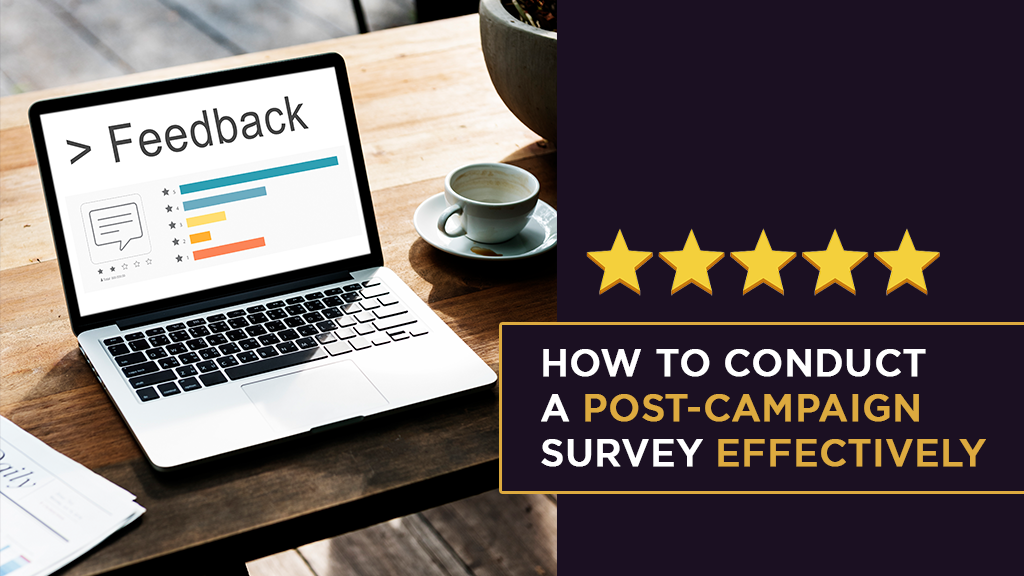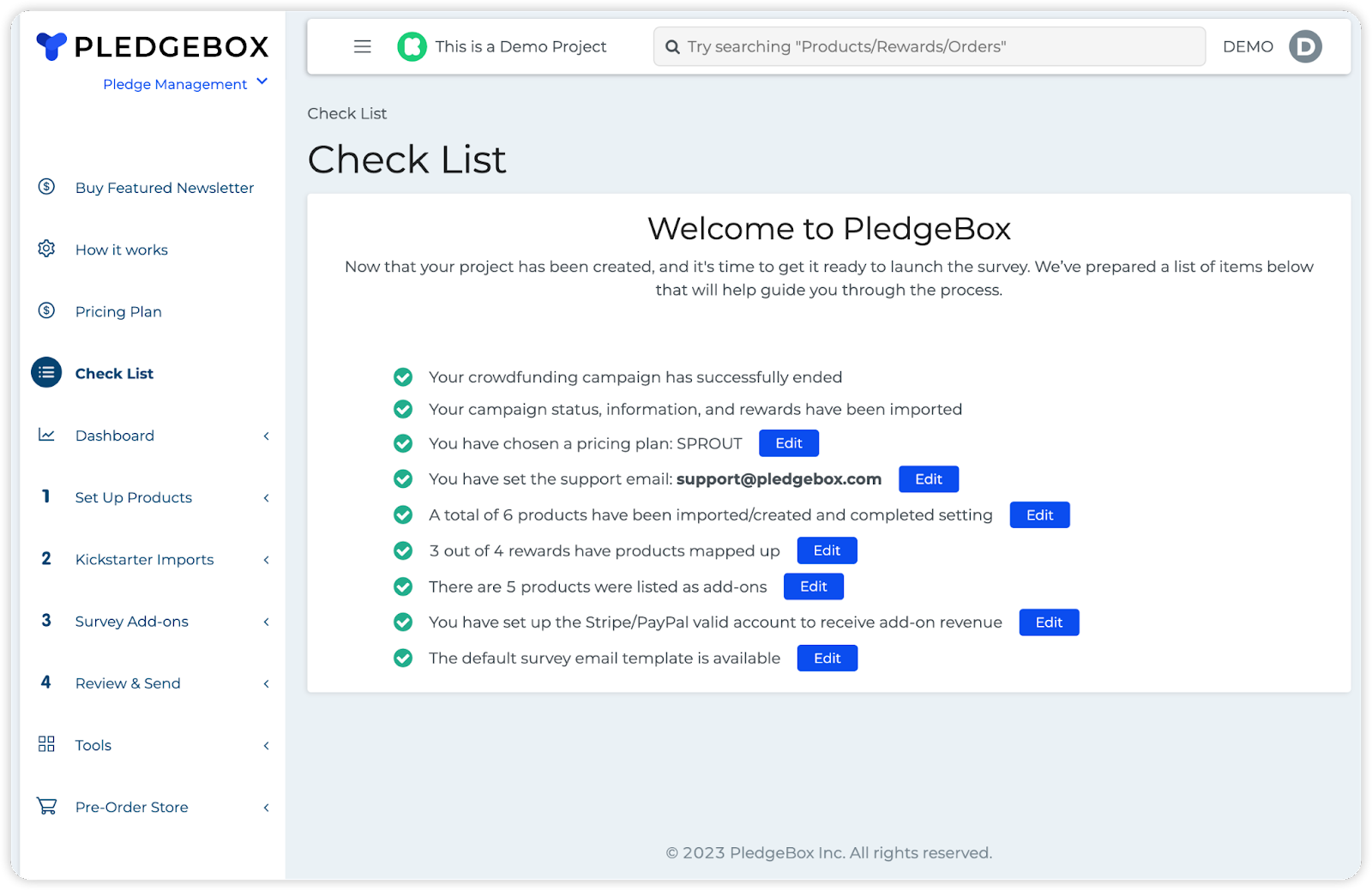
When your campaign finishes, the first thing you need to do is give yourself a big pat on the back! You’ve accomplished something incredible.
The second thing you need to do is start organizing your post-campaign survey. This pivotal step will allow you to perform a number of tasks in relation to your backers, including gathering information, upselling, and making sure you’ll be able to fulfill your product delivery effectively.
There are many post-campaign dos and don’ts, and conducting a good post-campaign survey is high on the list of best practices. Let’s explore all the ways you can employ this survey, as well as how to use it most optimally for success after your crowdfunding campaign.
Contents
- What is a post-campaign survey?
- Why is it important to conduct a post-campaign survey?
- When is the best time to send out your post-campaign survey?
- Steps to make an effective post-campaign survey
- Final thoughts on how to conduct a post-campaign survey effectively
- How to conduct a post-campaign survey: Frequently Asked Questions
What is a post-campaign survey?

First of all, what is a post-campaign survey and what does it have to do with crowdfunding? These aren’t thank you notes, fulfillment updates, or surveys aimed at campaign evaluation. These specific surveys are typically used after a campaign has finished to efficiently gather information from everyone who has backed your product.
They exist in two places: in the crowdfunding platform, or in third-party pledge managers.
Crowdfunding platform surveys
Kickstarter comes equipped with a built-in pledge manager. If you’re planning to launch on Kickstarter, be aware that it also comes with post-campaign survey management capabilities. And while it is basic in terms of features, it is free, and will allow you to conduct your survey all the same.
Indiegogo, on the other hand, does not have a post-campaign survey feature built into its pledge management tools. The reason is because Indiegogo has backers specify things like shipping and product variant information at the time of checkout. If you’re launching on Indiegogo, you need to be aware of this.
When using Kickstarter, your survey capabilities will be basic, and Indiegogo won’t let you run a survey at all. This is where the option to use a third-party pledge manager comes into play.
Third-party surveys
There are many third-party tools available to creators, from email marketing platforms, to post-campaign analytics tools, to pledge managers.
Two of the best third-party pledge managers with post-campaign survey capabilities are PledgeBox and BackerKit. Though they come with additional fees, the advantage of using them is the plethora of features they offer. Think of them as your complete post-campaign activities managers.
Once your Kickstarter or Indiegogo campaign ends, you can set up your account on one of these third-party platforms and import all of your backers’ information. From there, you can easily manage fulfillment, take advantage of built-in upsell features — and of course — conduct your post-campaign surveys.
Sending out surveys doesn’t need to be scary, and embracing third-party pledge managers can help take much of the heavy lifting out of this important process.
Why is it important to conduct a post-campaign survey?
You might be thinking: is it really worth going through this extra trouble just to send out a survey? After all, you can imagine how exhausted you’ll be after your campaign finally comes to a close.
The truth is, post-campaign surveys enable creators to do some important things that make backer fulfillment a more efficient process. The most vital thing for you to accomplish at this point is to deliver your product as promised to every single backer. Failing to do so can have negative ramifications that echo beyond your crowdfunding campaign as you transition to e-commerce.
Here are some of the ways these surveys can help your post-campaign phase:
- You can get backers’ most up-to-date information: From product variant information to shipping addresses, to ideas for additional add-ons, surveys let you collect the valuable data you need for fulfillment.
- You can gather data efficiently: Kickstarter and third-party pledge managers organize the data you collect and present it accurately so you can make informed decisions faster.
- You can raise more money: Surveys allow you to not only upsell additional products but also recover failed Kickstarter payments and collect mission shipping fees that may have fallen through the cracks during your campaign.
Now that you know why you need to conduct post-campaign surveys, it’s time to explore the best time to send them out for maximum backer engagement.
When is the best time to send out your post-campaign survey?
When it comes to the best time for sending out the survey to your backers, there isn’t a single most optimal moment to do so. Instead, you want to aim for an ideal window of time after your campaign has ended to start collecting backer information.
General best practice says to send out the post-campaign survey at least 14 days after closing, but no longer than a week or two after that. While it’s easy to procrastinate on this due to the demand manufacturing your product will require, doing so can be detrimental to fulfillment. Let’s explore why that is.
Avoid double charging
While it sounds strange, being too early with the survey can sometimes be inefficient. This is because backer credit cards get charged within the first seven days after a campaign has ended, and then can require up to seven more days for the crowdfunding platform to charge them.
Occasionally, some backer payments may get caught in limbo or fail to process, so waiting until after this grace period allows you to determine if you can safely collect payment information again. Trying to process failed payments too soon before the 14-day window is over can result in double charges, which is an extra headache you should avoid when you can help it.
Avoid delayed responses
Even if you send your survey out the day after your campaign ends, you’ll inevitably run into those few backers who are slow to respond. If you were just conducting a survey to upsell additional add-ons, it wouldn’t be much of a problem; however, you’ll likely need more important information about fulfillment, so delayed responses can backfire come shipping day.
In a perfect world, you’d get a timely one-hundred-percent response rate. Unfortunately, that’s not always the case, so take the necessary precautions and send your survey within a couple of weeks at the latest.
Avoid coming across as lazy
Part of keeping backers engaged post-campaign is keeping the gaps in communication with them to a minimum. Going radio silent for a couple of months after the campaign has ended can send out some red flags that you might be a scam.
Beyond that, sending out your post-campaign sooner rather than later tells your backers that you are organized and you know what you are doing. This reassurance can go a long way toward building trust in your community that you can leverage in the future should you decide to return to crowdfunding.
Steps to make an effective post-campaign survey
Now that you know when you should send your survey, it’s time to go through some best practices for making them as effective as possible. You don’t want to make a bad impression on your backers by spamming their inboxes with redos.
Let’s explore some tips for getting your post-campaign survey right the first time.
Step #1: Plan ahead

You’re aware of the ideal window for sending out your survey, but that doesn’t mean you can’t get started on it beforehand. There are many benefits to drawing up a clear and organized timeline for conducting your post-campaign crowdfunding survey. Not only does it force you to hold yourself accountable to a schedule, it can motivate you to start organizing your survey questions ahead of time.
Another major benefit of planning ahead is that you can familiarize yourself with how your survey tools work. Whether you’re using Kickstarter’s built-in survey, or a third-party tool with more features, the last thing you want to do is fall behind schedule because you weren’t sure how to navigate your post-campaign survey setup.
Step #2: Keep your backers informed
By the time you finish your crowdfunding campaign, you will have probably already started setting up your different communication channels to keep your backers updated. You want to make sure you’re putting this to good use, and that includes sending updates about an upcoming survey.
When you send one or two announcements of the backer survey leading up to the big day, you decrease the likelihood of people missing the survey when it goes out. The smoother any process is for them in crowdfunding, the smoother it will be for you when it comes time to ship your product.
Step #3: Don’t forget to collect add-on related information
Not everyone will have created add-ons in their campaigns, so this step won’t be applicable for them. For those that did though, it’s recommended to include optional questions in the post-campaign survey to let backers who purchased add-ons provide the necessary information for fulfillment, such as desired colors, sizes, or quantities.
If you can make certain fields optional in your survey tool, backers who didn’t get add-ons can simply leave the box blank and still be able to complete the survey. If you aren’t able to provide this option, be sure to instruct backers to fill in the optional fields with “Not Applicable” or “N/A.”
Step #4: Sort out shipping details as much as possible
Shipping is one of the most daunting things you’ll have to undertake in your crowdfunding journey. The post-campaign survey is your opportunity to gather all shipping-related information from your backers, and you want to be sure you’re charging the right prices and gathering the correct data.
As early in the game as possible, it helps to choose the right shipping partner to meet your and your backers’ needs. Once you know who that is, you’ll want to hammer out shipping details and costs. Consider things like domestic and international rates, and double-check with your shipping partner to make sure they’ve calculated based on the correct weight of your product.
Step #5: Send out a test survey
It’s a great feeling when your survey is ready to send, but it’s never great if you send it to your backers riddled with errors. Third-party pledge managers come with a useful tool that allows you to send out a test survey to a small percentage of your backers so you can troubleshoot any potential problems before going fully live with it.
We strongly recommend you do this if your post-campaign survey tool has the capability built-in. Think of this as an extension of the testing mindset you will have adopted from the earlier phases of your crowdfunding campaign.
Final thoughts on how to conduct a post-campaign survey effectively
An important thing to keep in mind is to not overcomplicate the post-campaign survey process. There are many moving parts when it comes to product fulfillment, and you don’t want to stretch yourself too thin. Design your survey to be as simple as possible, and transfer your backer data onto an easy-to-read .csv file that you can open on any spreadsheet program when you’re finished.
Please note, though, that your surveys will contain sensitive personal information. It is your responsibility to protect it, so do not share it with any third parties you do not trust, and make sure you keep the exported file with all of the data safely locked.
Overall, conducting a post-campaign survey is fairly routine and shouldn’t give you much trouble if you’ve selected a tool you’re comfortable with. However, we know that getting things right the first time is important, which is why LaunchBoom is here to help however we can. If you’d like to consult one of our crowdfunding experts, be sure to fill out a form at the bottom of this page to set up an appointment.
How to conduct a post-campaign survey: Frequently Asked Questions
We hope this article helped navigate your upcoming post-campaign survey process. If you still have further questions, we don’t blame you! Here are some of the most frequently asked questions we hear about how to best send surveys to backers after a crowdfunding campaign.
What is the ideal time to run a post-campaign survey?
The ideal window for running your survey is at least 14 days after the close of your campaign and no longer than a week or two after that. The absolute latest is one month after your campaign has ended, but be sure to keep backers informed that it’s coming.
Who should be targeted?
These surveys should only be sent to the backers of your most recent crowdfunding campaign. If you’ve run multiple campaigns, be very careful not to combine the different email lists you’ve compiled.
What type of questions should be included?
The scope of your post-campaign survey questions should be limited to the following:
- Shipping information
- Product-specific information like sizes, colors, etc.
- Add-on upsells
- Payment issues
How long should a post-campaign survey be?
Post-campaign surveys shouldn’t be long at all. They should take no more than a few minutes for someone to complete, and instructions should be straightforward. All of the survey tools you have at your disposal are streamlined enough to make this achievable.
How can I ensure a high response rate?
One thing that helps with better response rates is communicating with backers between the end of your campaign and the start of your survey. Let them know via your various communication channels, such as social media, email, or the Updates tab on your crowdfunding platform when they can expect to take the survey.
How do I analyze the data collected?
Post-campaign survey tools allow you to export your data as .csv files so that you can organize the data in the spreadsheet program of your choice.
How can the results of the survey be used?
The results are all extremely important for product fulfillment. Use the data you gather to ensure you don’t make any costly shipping or manufacturing mistakes.




